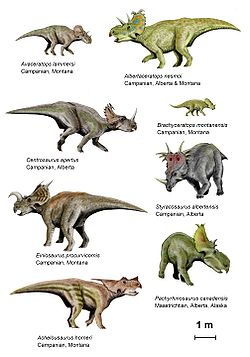- Centrosaurinae
-
Centrosaurines
Temporal range: Late Cretaceous, 77–69 Ma
Various species of centrosaurines Scientific classification 
Kingdom: Animalia Phylum: Chordata Class: Reptilia Superorder: Dinosauria Order: †Ornithischia Suborder: †Ceratopsia Family: †Ceratopsidae Subfamily: †Centrosaurinae
Lambe, 1915Type species Centrosaurus apertus
Lambe, 1904Subgroups Synonyms - Pachyrhinosaurinae Sternberg, 1950
The Centrosaurinae is a subfamily of ceratopsid dinosaurs named by paleontologist Lawrence Lambe, in 1915, with Centrosaurus as the type genus. The centrosaurines are further divided into two tribes, the centrosaurins and the pachyrhinosaurins.[1]
Contents
Classification
The cladogram presented here follows a 2011 phylogenetic analysis by Fiorillo and Tykoski.[2]
Centrosaurinae Diabloceratops eatoni
Albertaceratops nesmoi
"Centrosaurus" brinkmani
Centrosaurus apertus
Styracosaurus albertensis
Pachyrhinosaurini Rubeosaurus ovatus
Einiosaurus procurvicornis
Pachyrostra Achelousaurus horneri
Unnamed species (TMP 2002.72.1)
Pachyrhinosaurus lakustai
Pachyrhinosaurus canadensis
Pachyrhinosaurus perotorum
Reproduction
Possible neonate sized centrosaurine fossils have been documented in the scientific literature.[3] Research indicates that centrosaurines did not achieve adult morphology with its accompanying mating signals until nearly fully grown.[4] Relative age of the animals was determined based on the size, degree of coossification, secondary ossification, and growth related changes in bone texture.[4] Sampson finds commonality between the retarded growth of mating signals in centrosaurines and the extended adolescence of animals whose social structures are ranked hierarchies founded on age-related differences.[4] In these sorts of groups young males are typically sexually mature for several years before actually beginning to breed, when their mating signals are most fully developed.[5] Females, by contrast due not have such an extended adolescence.[5]
Footnotes
- ^ Sampson (1995).
- ^ Fiorillo, A.R. and Tykoski, R.S.T. (in press). "A new species of the centrosaurine ceratopsid Pachyrhinosaurus from the North Slope (Prince Creek Formation: Maastrichtian) of Alaska." Acta Palaeontologica Polonica, available online 26 Aug 2011. doi:10.4202/app.2011.0033
- ^ "Abstract," Tanke and Brett-Surman (2001). Page 207.
- ^ a b c "Retarded Growth of Mating Signals," Sampson (2001); page 270.
- ^ a b "Sociological Correlates in Extant Vertebrates," Sampson (2001); page 265.
References
- Sampson, S. D. (1995b). "Two new horned dinosaurs from the Upper Cretaceous Two Medicine Formation of Montana; with a phylogenetic analysis of the Centrosaurinae (Ornithischia: Ceratopsidae)." Journal of Vertebrate Paleontology, 15(4): 743-760.
- Sampson, S. D., 2001, Speculations on the socioecology of Ceratopsid dinosaurs (Orinthischia: Neoceratopsia): In: Mesozoic Vertebrate Life, edited by Tanke, D. H., and Carpenter, K., Indiana University Press, pp. 263-276.
- Tanke, D.H. and Brett-Surman, M.K. 2001. Evidence of Hatchling and Nestling-Size Hadrosaurs (Reptilia:Ornithischia) from Dinosaur Provincial Park (Dinosaur Park Formation: Campanian), Alberta, Canada. pp. 206-218. In: Mesozoic Vertebrate Life—New Research Inspired by the Paleontology of Philip J. Currie. Edited by D.H. Tanke and K. Carpenter. Indiana University Press: Bloomington. xviii + 577 pp.
External links
Categories:- Ceratopsians
Wikimedia Foundation. 2010.
